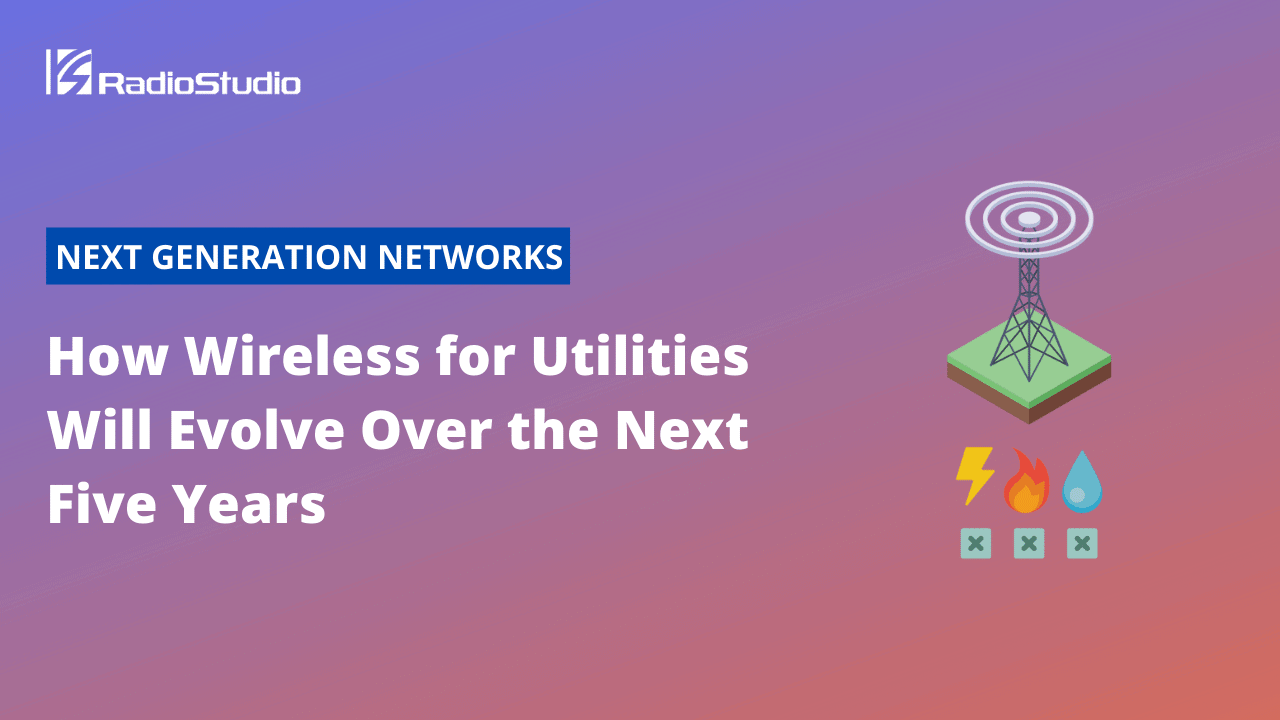As the connected world moves towards a wireless internet world, an increasing number of connectivity options will become available to utilities. Wireless device ecosystems and network security is evolving to meet the reliability needs for grid modernization. This blog discusses how wireless for utilities will evolve over the next five years. We will also explore different connectivity alternatives for IoT, how 5G/Wi-Fi 6 fits in, and how to secure a network that bridges today to tomorrow.
This article was originally published by Ericsson.
,gravity=Center)
In this blog series we started with an overview of the components of a power grid and how wireless enables greater control and awareness. We first focused on LTE, based on the maturity of the utility device ecosystem in LTE. Then we looked at capillary networks, which will bring convergence between cellular and unlicensed networks in the last hop of the last mile in the community, where power lines meet the prosumer and the smart home.
Over the next five years, Ericsson envisions evolution in utilities connectivity moving in two directions:
- First, the more latency-sensitive use cases on the power grid will move from microwave/fiber to low-latency 5G wireless as more spectrum gets assigned to modernize the Smart Grid
- Next, Utilities will leverage the best of breed between 3GPP and IEEE technologies in an enhanced Converged Cellular Capillary Network that would also include 3GPP 5G and IEEE Wi-Fi 6, depending on device performance needs
To understand this better, let’s look at the following pieces to this puzzle:
- Different Connectivity Alternatives for IoT
- 5G vs Wi-Fi 6
- Advantages of 5G, deploying multiple 3GPP wireless technologies
- Security aspects of the bridge/Capillary Networks
Different Connectivity Alternatives for IoT
Connectivity is the foundation for IoT and the type of access (mesh, LTE, NB-IoT, LTE-M) deployed depends upon the nature of the application. Many IoT devices are being served by radio technologies that operate on unlicensed spectrum. These radios and devices are designed for short-range connectivity with limited Quality of Service (QoS) and security requirements, typically for a home or indoor environment. Currently, there are two alternative connectivity tracks for IoT applications that depend on wide-area coverage:
- Cellular technologies: 3GPP technologies like GSM, WCDMA, LTE and 5G NR operate primarily on licensed spectrum and historically have preeminently targeted high-quality mobile voice and data services. Narrowband IoT (NB-IoT) and LTE for machine-type communication (LTE-M) are optimized access technologies for low power wide-area (LPWA) applications that are focused on coverage and reliability.
- Unlicensed LPWA: Proprietary radio technologies provided by, for example, Sigfox and LoRa, have been developed and designed solely for MTC applications addressing the ultra-low-end device segment, with very limited demands on throughput and QoS. However, the deployment of these technologies requires end-to-end establishment of a single-use dedicated access network and dedicated core infrastructure.
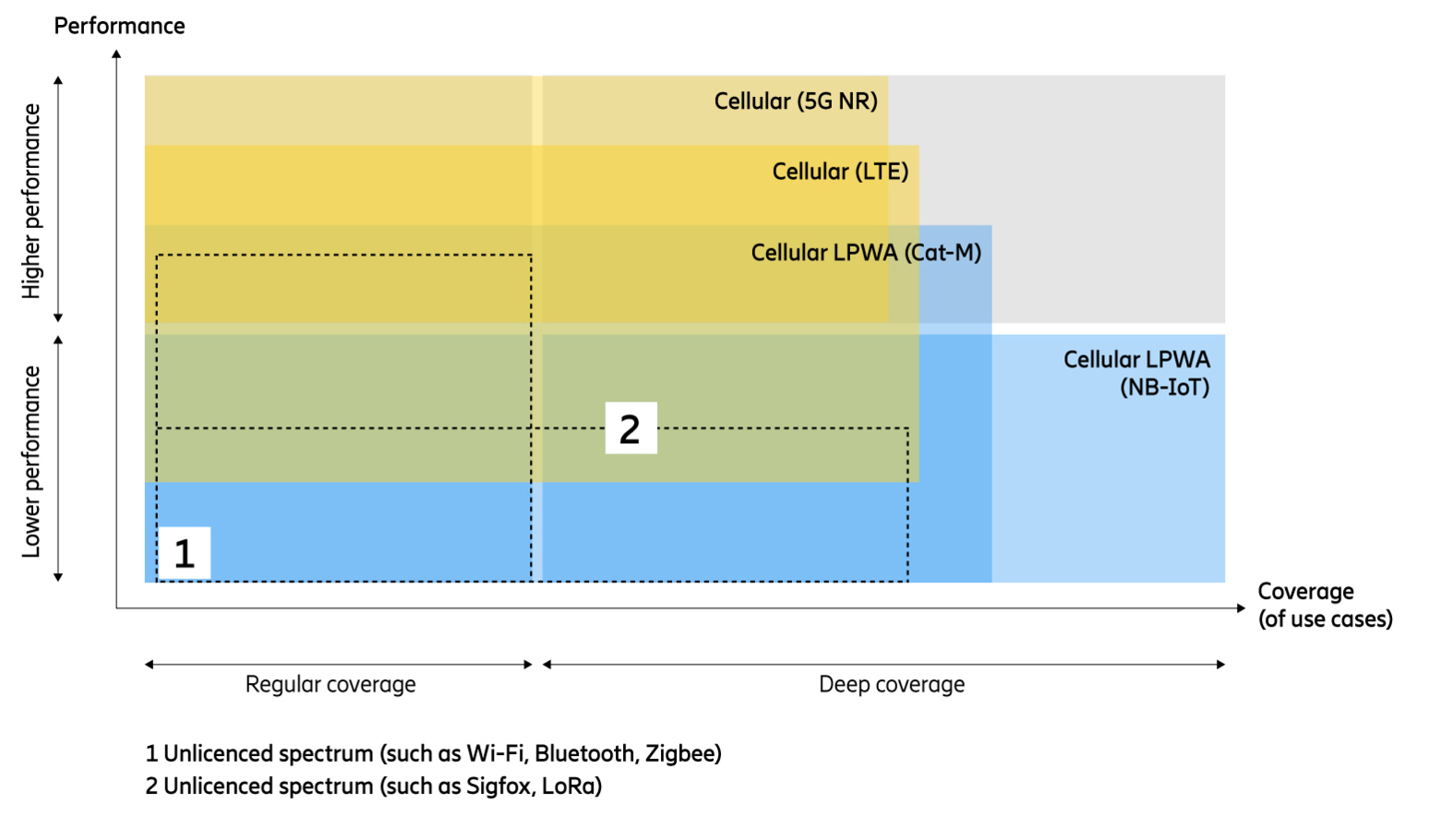
Ericsson is no stranger to unlicensed technologies, and invented Bluetooth technology in 1994; this replaced wired communication between the mobile phone and headset. Unlicensed personal/short range networks have evolved quite a bit since then, and provide the foundation for many of the single-use-case technologies in the last hop.
Within the utilities last mile, and for large geographic, contiguous and reliable coverage, the device and network ecosystem for LTE is widespread and well established. LTE can be leveraged for grid modernization in the short/medium term, followed by 5G NR in the long term. In addition to LTE, for the LPWA specific use cases, LTE-M technology extends LTE with features for extended device battery life, enhanced coverage and support for a low-complexity device category series, named Cat-M. NB-IoT is a standalone radio access technology based on the fundamentals of LTE that enables extreme coverage and extended battery life for ultra-low-complexity devices. Both CAT-M and NB-IoT support are planned for 5G.
In the last hop and smart home integration into the smart grid, the comparatively high device price points in LTE would drive utilities to continue using existing unlicensed technologies like Zigbee, BLE, Sigfox, LoRa—while they wait for the LTE device ecosystem price points to be more affordable.
Even if existing 3GPP end-to-end connectivity is not feasible, cellular technology can still provide key benefits when used as a bridging option, for instance, as an aggregation and routing solution. This capillary network approach allows end devices to utilize varying access solutions from either the short range or LPWA domain and access the cellular networks via an LTE gateway device. Capillary networks enable the reuse of cellular functions and assets, such as security, device management, billing and QoS without requiring each end device to be cellular enabled. As an example, utility devices such as meters and sensors in a building may communicate over Bluetooth to one main gateway, which then connects with a server application over LTE/Cat-M/NB-IoT. (More on this in the security discussion later in this blog.)
5G vs Wi-Fi 6
With the arrival of every new generation of technology, the comparison of 3GPP and IEEE-based solutions have traditionally been a hot topic for discussion. Both 5G and Wi-FI 6 standards are technologically superior to their predecessors, and each has a role to play in today’s and tomorrow’s utilities networks. The technologies should be viewed as coexisting solutions, each offering substantial benefits, depending on the deployment situation.
The boost in Wi-Fi 6 in terms of capacity, efficiency and flexibility (compared to Wi-Fi 5) is based on technology priorities similar to 5G. Unlike its predecessor, Wi-Fi 5 (IEEE802.11ac), the new standard can support up to 12 simultaneous user streams from a single Wi-Fi access point as well as 8×8 multiuser MIMO for both uplink and downlink. Wi-Fi 6 offers greater flexibility for deploying channel sizes from 20MHz to 160MHz, accommodating specific use case requirements. The addition of OFDMA improves Wi-Fi performance, driving greater efficiency, and providing lower latencies in indoor locations like arenas, auditoriums and other high-density environments. Wi-Fi is certain to continue providing last-hop access to wireless devices in people’s homes and non-critical access in mainly indoor deployments.
5G, on the other hand, is a complete solution for enhanced mobile broadband (eMBB), massive machine-type communication (M-MTC), critical machine-type communication (C-MTC) and fixed wireless access (FWA). It supports both the wide-area and indoor connectivity needs of consumers, enterprises and the public sector. Many of the major service providers around the world have started deployments for many of these use cases using industry-leading solutions from Ericsson.
5G NR dramatically boosts wireless capability for utilities. It leverages a flexible and scalable physical layer for handling diverse scenarios; ultra-lean design for energy efficiency; advanced critical MTC features for ultra-reliability, ultra-low latency and interruption-free mobility, Time- Sensitive Networking (TSN), and fully flexible end-to-end network slicing and QoS framework. For the 5G consumer, additional capabilities introduced in 5G include a wide range of frequencies (sub-1GHz to 100GHz) with very large bandwidths, seamless carrier aggregation across multiple bands and a massive number of steerable antenna elements—all of which allow for wireless fiber capabilities.
Wi-Fi is sufficiently secure for office and home use. But 5G addresses a much larger security issue, accounting for end-to-end security and global identity management. With these capabilities, 5G NR is a much more attractive technology for addressing demanding connectivity requirements than the earlier generations of cellular systems.
Advantages of 5G
One of the primary advantages of 5G vs 4G is faster transition to data connection (for instance, 150ms to 25ms) as shown in Figure 2 below due to the new state “RRC Connected Inactive,” which suspends the data connection between consecutive requests for internet access. 5G also allows for larger 100MHz carriers for increased throughput—although this advantage may not apply to spectrum dedicated to utilities. The 25ms time to restoration of internet access allows for increased support for mission-critical use cases and quick alarming in critical scenarios such as a fallen conductor.
5G supports channel sizes ranging from 5MHz to 100MHz for bands below 6GHz, and channel sizes from 50MHz to 400MHz in bands above 24GHz. The full capabilities of 5G will be best realized through the wider channel sizes in new 5G bands.
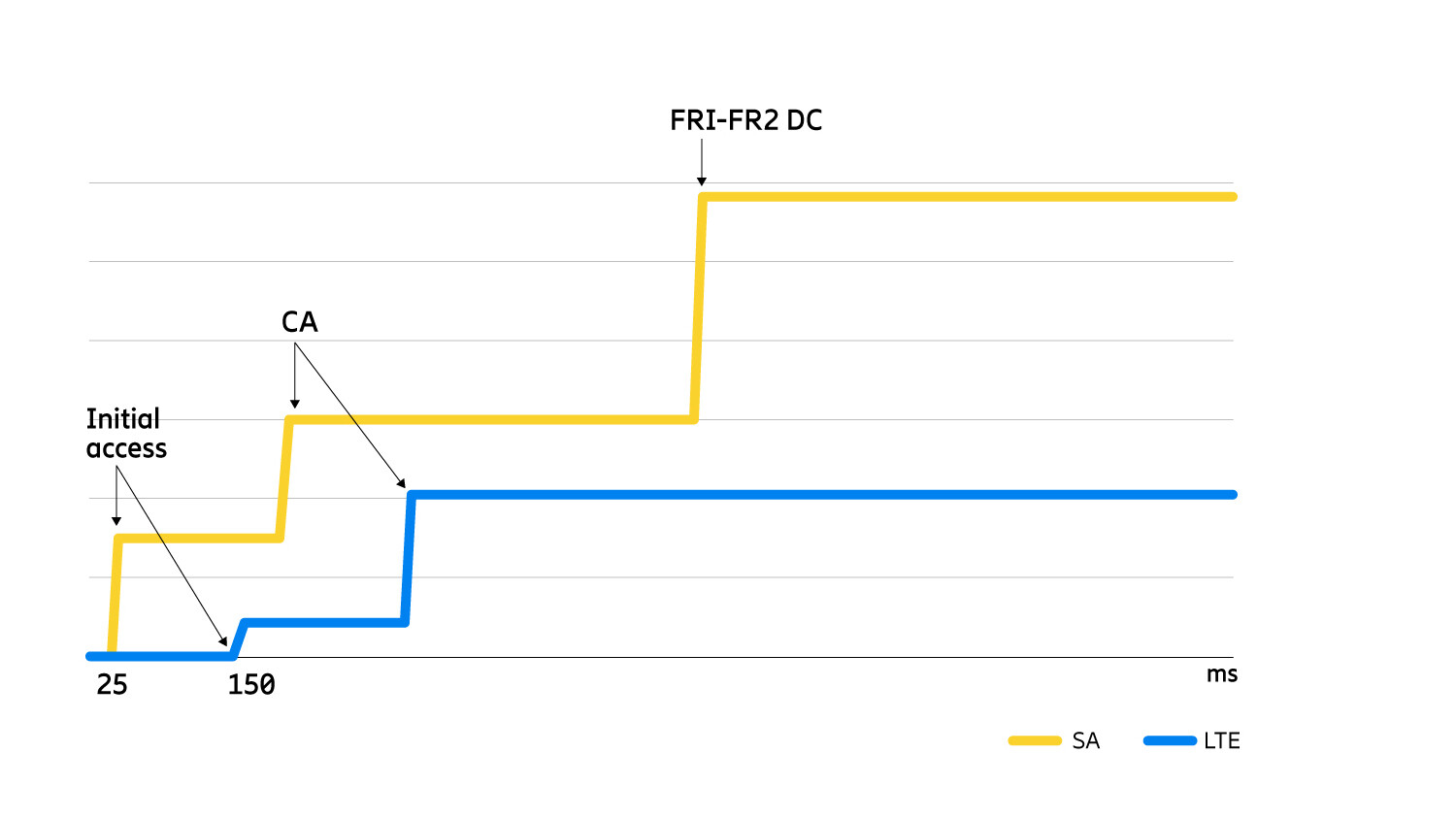
The insights above are based on Ericsson trials and deployments around the world. Depending on configuration optimizations, the average latency on LTE is 50ms or better. This allows for some of the following wireless use cases in LTE-based grid modernization:
| Current Transmission Application Examples | |
| Application | Delay Budget |
| SynchroPhasor Measurements | 60 ms |
| SCADA Data Polling | 100 ms |
| Mission-Critical PTT | 75 ms |
| PTT | 100 ms |
| Dynamic Line Rating | 200 ms |
| CCTV | 200 ms |
| Most Substation SCADA apps | 250 ms |
| Field Svc and Enterprise Apps | 250 ms |
With the enhancements to the state machine brought in by 5G, this family of use cases can be extended by 5G to address latencies of 10ms or better, depending on the spectrum and bandwidth available to the utility. For example:
| Potential 5G* Application Additions | |
| Application | Delay Budget |
| High Voltage System Protection | 6-12 ms |
| Under-frequency Load Shedding | 10 ms |
| HV Breakers/Reclosers | 16 ms |
| Lockout Functions | 16 ms |
| HV Transformer Protection and Control | 16 ms |
In the journey ahead from 4G to 5G, spectrum is always a consideration. Ericsson deployments innovatively use Dynamic Spectrum Sharing, in which the same channel of spectrum can be used simultaneously for LTE and 5G. In addition to this, both Cat-M and NB-IoT can efficiently coexist in the same band as an NR carrier. Dynamic spectrum sharing in the same band between all four technologies Cat-M, NB-IoT, LTE and NR are already supported in 3GPP Release 15 and additional enhancements are being standardized as part of Release 16.
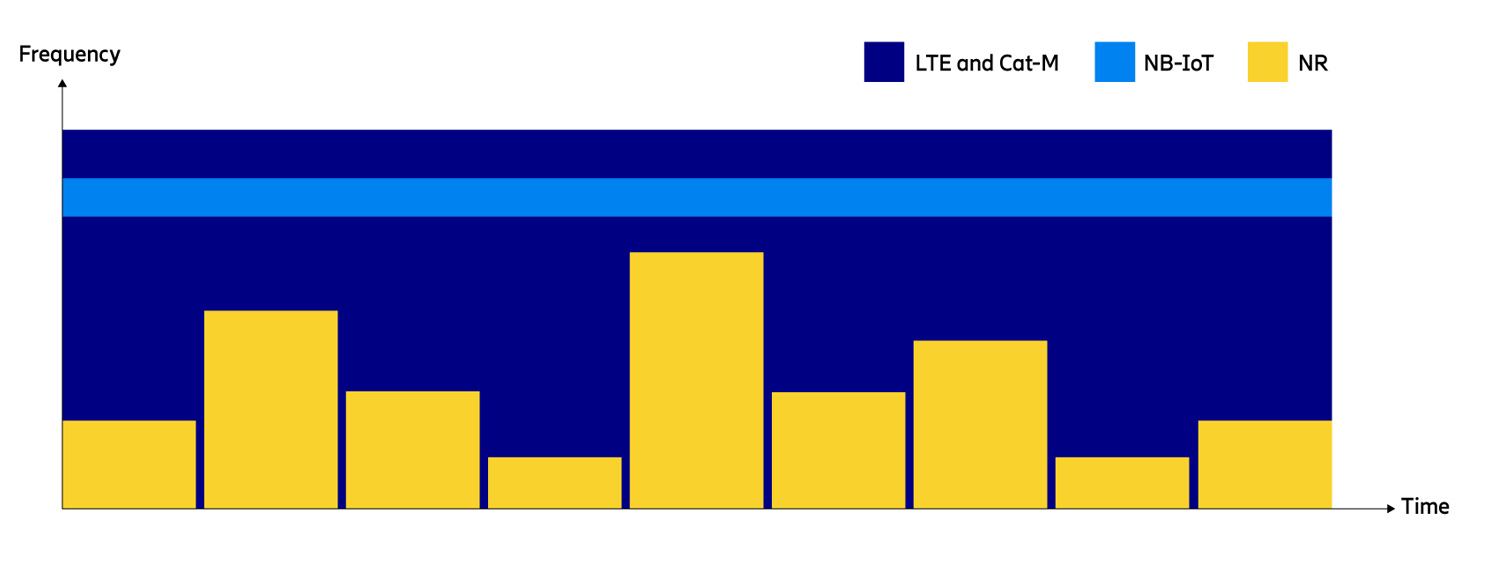
Security Aspects of the Converged Cellular Capillary Network
Bringing it all together, the pragmatic short term solution is to address the last hop and smart home with the relatively inexpensive devices in licensed/unlicensed spectrum. Last mile access and grid modernization is best provided with the reliability and wider reach in large geographies with LTE/5G. The bridge between the unlicensed Last hop and the licensed Last mile is provided by the LTE gateway in a capillary network that converges 3GPP (LTE, 5GNR, LTE-M, NB-IoT) and non-3GPP mesh (such as Zigbee, BLE, LoRa, Sigfox) devices into a single network.
Enabling end-to-end security in this converged mission-critical capillary network is of utmost importance.
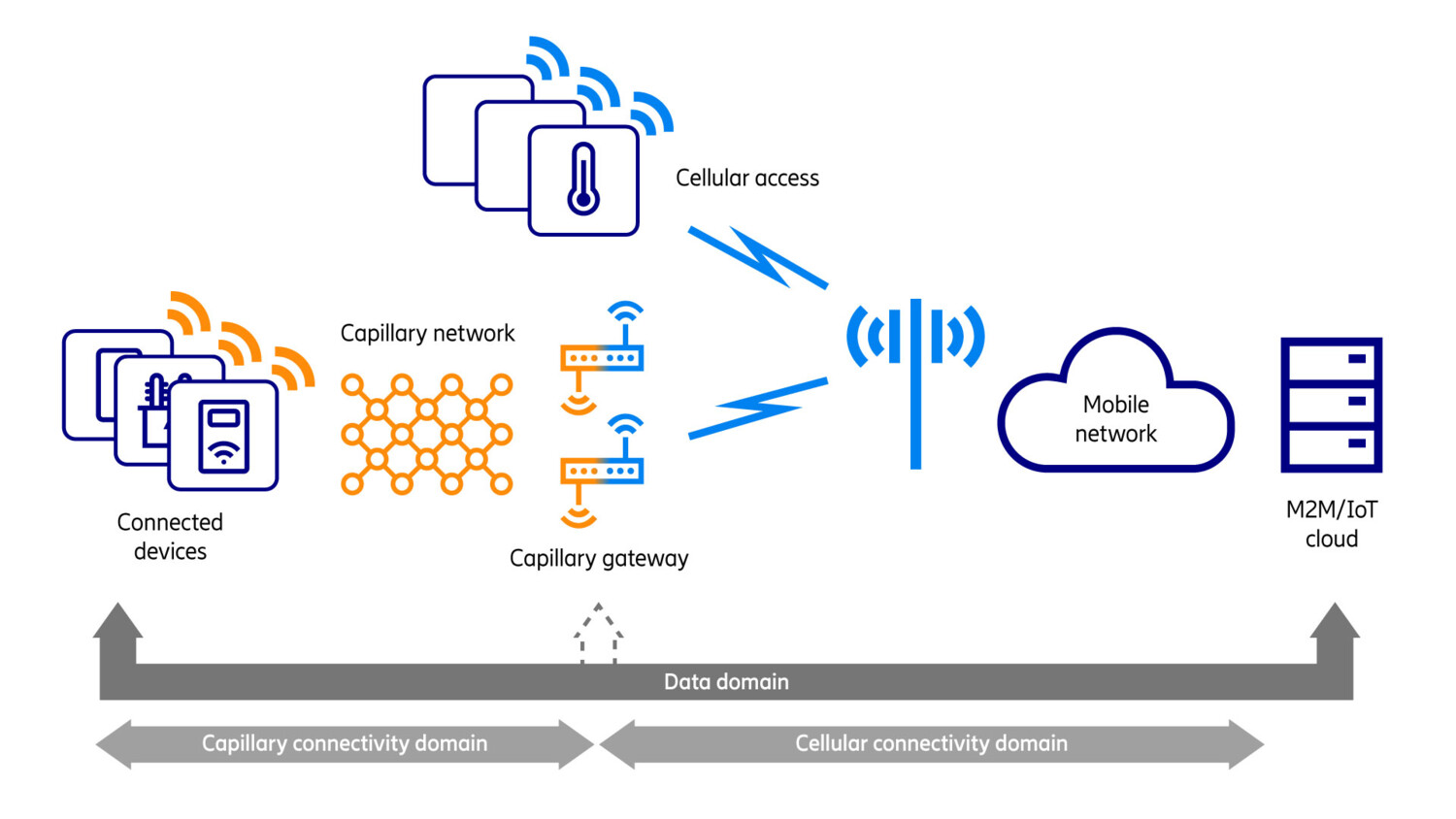
The devices deployed in capillary networks are likely to vary significantly in terms of size, computational resources, power consumption and energy source. Security in capillary networks does not follow a one-size-fits-all model because the devices in the capillary network are often constrained in the amount of resources for security algorithm processing. Learn more details on capillary networks in this Ericsson Whitepaper on cellular networks for Massive IoT.
Devices installed in a capillary network usually store credentials such as public key certificates, raw public keys or a shared secret that may not be 3GPP credentials. These non-3GPP devices, therefore, depend on the 3GPP-enabled capillary gateway to provide security through the private LTE network to connect to devices on the internet or to their head-end systems.
The security bridge between the constrained non-3GPP and network authenticated 3GPP devices in a capillary network can be addressed with GBA (Generic Bootstrapping Architecture) – a mechanism that the capillary gateway, equipped with a SIM or eSIM, uses to provide non-LTE devices wih security similar to LTE User Equipment (UE). The constrained devices would then use a process of “delegated GBA” to bring those security associations from the capillary gateway onto the device.
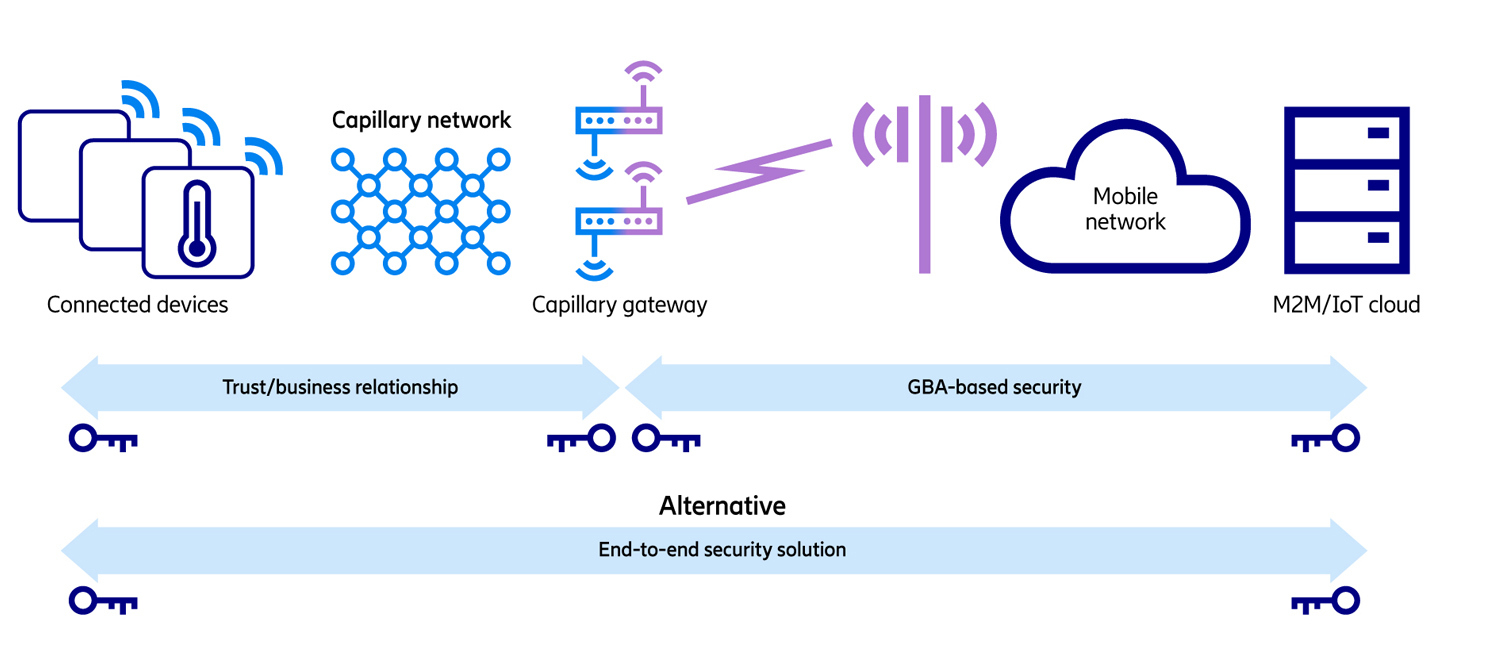
Often, the non-3GPP devices in the capillary network have a Trust/business relationship with the capillary gateway provider—not the end-to-end LTE security solution that we need for reliability. The GBA mechanism used by the Capillary Gateway (CGW) provides unique keys for each device that allow for the end-to-end security relationship to be established between the individual non-3GPP device and the LTE network. These session keys are also used by individual non-3GPP devices in the capillary network when they communicate with application functions in cloud or head-end systems.
Delegated GBA for Non-3GPP Devices
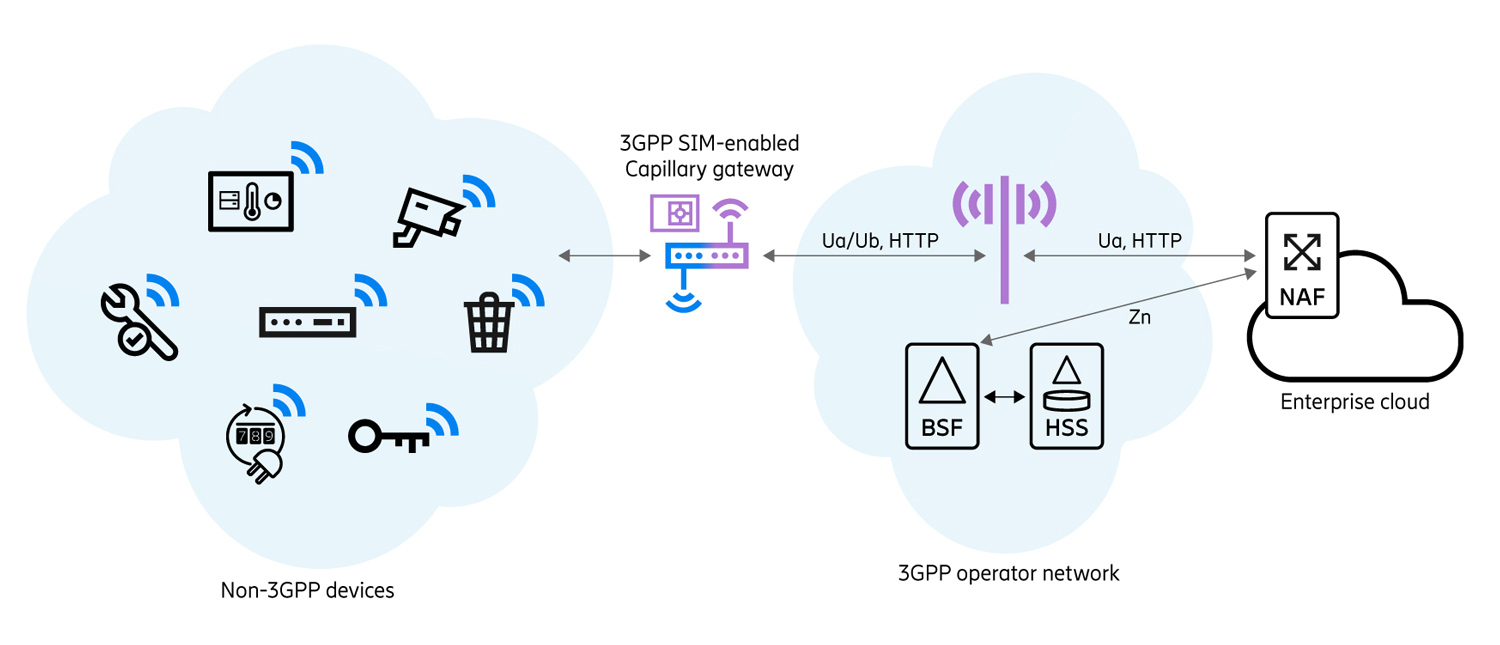
Once the capillary gateway has been authenticated with the LTE network, the CGW can be used by devices as a proxy for GBA authentication based on bootstrapping keys generated by GBA process. This is “delegated GBA” for non-3GPP devices that allows for establishment of an end-to-end security association between device and application/head-end systems.
A capillary network of 3GPP and non-3GPP technologies is a pragmatic way to bridge in the evolution of the Smart Grid to licensed LTE/5G-based wireless.
Conclusion
Cellular Wireless technologies like LTE, LTE-M, NB-IoT and 5G/NR enable widespread, reliable coverage to devices in the Smart Grid—providing a single wireless platform for multiple use cases. A single network simultaneously enables both wide-area high coverage/guaranteed reliability and local-area high performance/best effort networks. 3GPP networks also provide mechanisms to bridge SIM-based cellular with existing unlicensed mesh based coverage—bringing reliability to the last hop of the last mile of wireless coverage.

